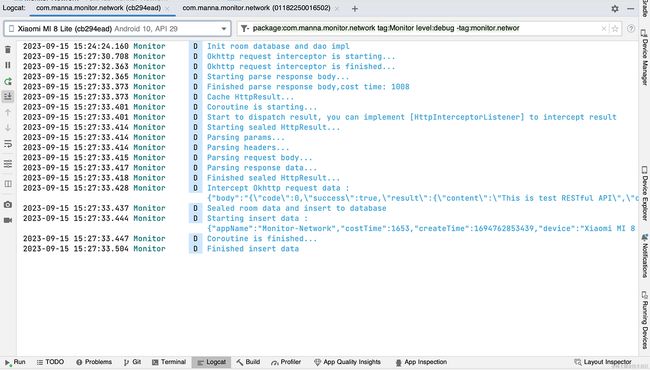Monitor-Network
基于 ServiceLoader,监控 Okhttp网络请求,实现拦截、解析、转发、存储、上报等功能。采用组件化开发方式,各业务组件均可单独拆分使用,同时提供export对外调用组件,外部调用无需关心内部实现,组件之间集成完全解耦
Github 地址 > https://github.com/MannaYang/Monitor-Network
集成组件介绍
Components-stone
- 提供基础依赖管理build.gradle.kts(可修改依赖版本)
- 提供DataStore/Gson/RetrofitProvider对外调用管理类(可替换)
- 提供NetworkInterceptor全局拦截器(Okhttp Interceptor)(如需替换,需全局处理接口注解)
- 提供Application生命周期分发管理,基于@AutoService注解生成并解耦(
如需替换,需全局处理接口注解)
Components-http-export
该组件为对外集成组件,可直接依赖
- HttpDataResult.kt
提供对外获取Interceptor拦截器解析实体model - HttpInterceptorListener.kt
提供对外转发实体model数据接口,可供上层业务获取网络请求数据并自定义处理,参考app组件模块[HttpInterceptor.kt]
Components-http
该组件是http-export内部业务实现组件,处理网络请求白名单、解析、转发等业务操作,不可直接依赖,建议上层business业务集成
- HttpInterceptor.kt
拦截原始okhttp网络请求,并组装实体模型HttpResult.kt - HttpResultParser.kt
解析原始请求header、body、formBody并组合[HttpDataResult]模型 - DispatchProvider.kt
通过异步协程与ServiceLoader转发http处理完成的数据模型
Components-room-export
该组件为对外集成组件,可直接依赖
- HttpDataEntity.kt
数据库表映射关联实体模型,供外部组合数据并存储数据源,参考app组件HttpInterceptor.kt - HttpDataManage.kt
数据库对外操作接口,提供增删改查及自定义查询sql功能 - QueryFilter.kt
自定义查询过滤条件,参考app组件MainActivity.kt
Components-room
该组件是room-export内部业务实现组件,提供room database、table、dao实现
- HttpDataBaseLifecycle.kt
生命周期内初始化room相关组件,获取dao操作实例 - HttpDataDaoProvider.kt
实体模型与Table表映射关系关联 - HttpDataManage.kt
数据库增删改查具体实现,关联room-export组件中[HttpDataManage.kt]
Components-report-export
该组件为对外集成组件,可直接依赖
- WorkReport.kt
对外开放业务查询过滤实体、业务上报平台区分,关联WorkManager-InputData参数
Components-report
该组件是report-export内部业务实现组件,提供WorkManager后台上报功能
- dingtalk
钉钉工作空间及鉴权服务与数据上报(仅作参考),具体实现可换为实际上报业务平台 - markdown
格式化上报报文(仅作参考),具体按实际业务要求处理 - work
处理数据上报及冗余数据处理(仅作参考),具体按实际业务要求处理
Components-app
上层业务集成组件壳,包含所有export及内部实现组件,组装额外公共参数(用户信息、设备信息、应用信息)
kapt("com.google.auto.service:auto-service:1.1.1")
api("com.google.auto.service:auto-service-annotations:1.1.1")
implementation(project(":stone"))
implementation(project(":http"))
implementation(project(":http-export"))
implementation(project(":room"))
implementation(project(":room-export"))
implementation(project(":report"))
implementation(project(":report-export"))具体调用方法在[MainActivity.kt]与[HttpInterceptor.kt],应用内BaseApplication应替换为项目实际使用类
使用说明
项目中为了演示效果采用钉钉上报,因此需要申请企业应用AppKey/SecretKey/AgentId/进行鉴权以,通过以上key信息获取UserIds完成消息推送通知,
实际应用中推荐上报到日志中台或相关日志平台,作为全链路监控的一环
钉钉开放平台 > https://open.dingtalk.com/
gradle.properties
需配置以下内容,关联影响鉴权方法位置 : DingRepository.kt
# Ding key config
dingAppKey=
dingSecretKey=
dingAgentId=
dingUsersId=实际调用代码示例
DingProvider.kt
suspend fun reportWorkSpace(title: String, content: String, success: (Boolean) -> Unit) {
...
...
...
}可自定义DataServerProvider.kt ,处理实际数据上报平台
suspend fun reportDataServer(title: String, content: String, success: (Boolean) -> Unit) {
//do something
}
suspend fun reportDataOther(title: String, content: String, success: (Boolean) -> Unit) {
//do something
}演示效果截图 screenshot
ServiceLoader
基于@AutoService注解生成的metadata可在各自组件build目录查看,例如:
- report/build/intermediates/java_res/debug/out/META_INF/services/*
- report/build/intermediates/runtime_library_classes_dir/debug/META_INF/services/*
- report/build/tmp/kapt3/classes/debug/META_INF.services
使用方式可参考各业务组件中含有@AutoService class,例如:
auto-service官方文档地址 > https://github.com/google/auto/tree/main/service
Declaration Interface
/**
* Define lifecycle methods what you want to use
*/
interface ApplicationLifecycle {
/** Lifecycle onAttachBaseContext */
fun onAttachBaseContext(context: Context)
/** Lifecycle onCreate */
fun onCreate(application: Application)
/** marking priority,0 is highest priority,next is 1,2,3...100 ,you can custom it */
fun priority(): Int
}Annotation Class
/**
* Add google [@AutoService] annotation,to implementation it
*/
@AutoService(ApplicationLifecycle::class)
class ApplicationLifecycleProxy : ApplicationLifecycle {
override fun onAttachBaseContext(context: Context) {
//do somethings
}
override fun onCreate(application: Application) {
//do somethings
DataStoreProvider.initDataStore(application)
}
override fun priority(): Int {
//in base application context,do somethings highest priority,so you should return 0
return 0
}
}ServiceLoader.load
/**
* With google auto-service,it will collect all @AutoService annotation class
*/
class ServiceLoaderProxy {
private val loader: ServiceLoader by lazy {
ServiceLoader.load(ApplicationLifecycle::class.java)
}
val lifecycleQueue by lazy { loader.sortedWith(compareBy { it.priority() }) }
} 引用三方库
- Google JetPacks > https://developer.android.com/jetpack
- Kotlin Coroutines > https://github.com/Kotlin/kotlinx.coroutines
- Retrofit & Okhttp > https://github.com/square/retrofit & https://github.com/square/okhttp
- Gson > https://github.com/google/gson
- auto-service > https://github.com/google/auto/tree/main/service


